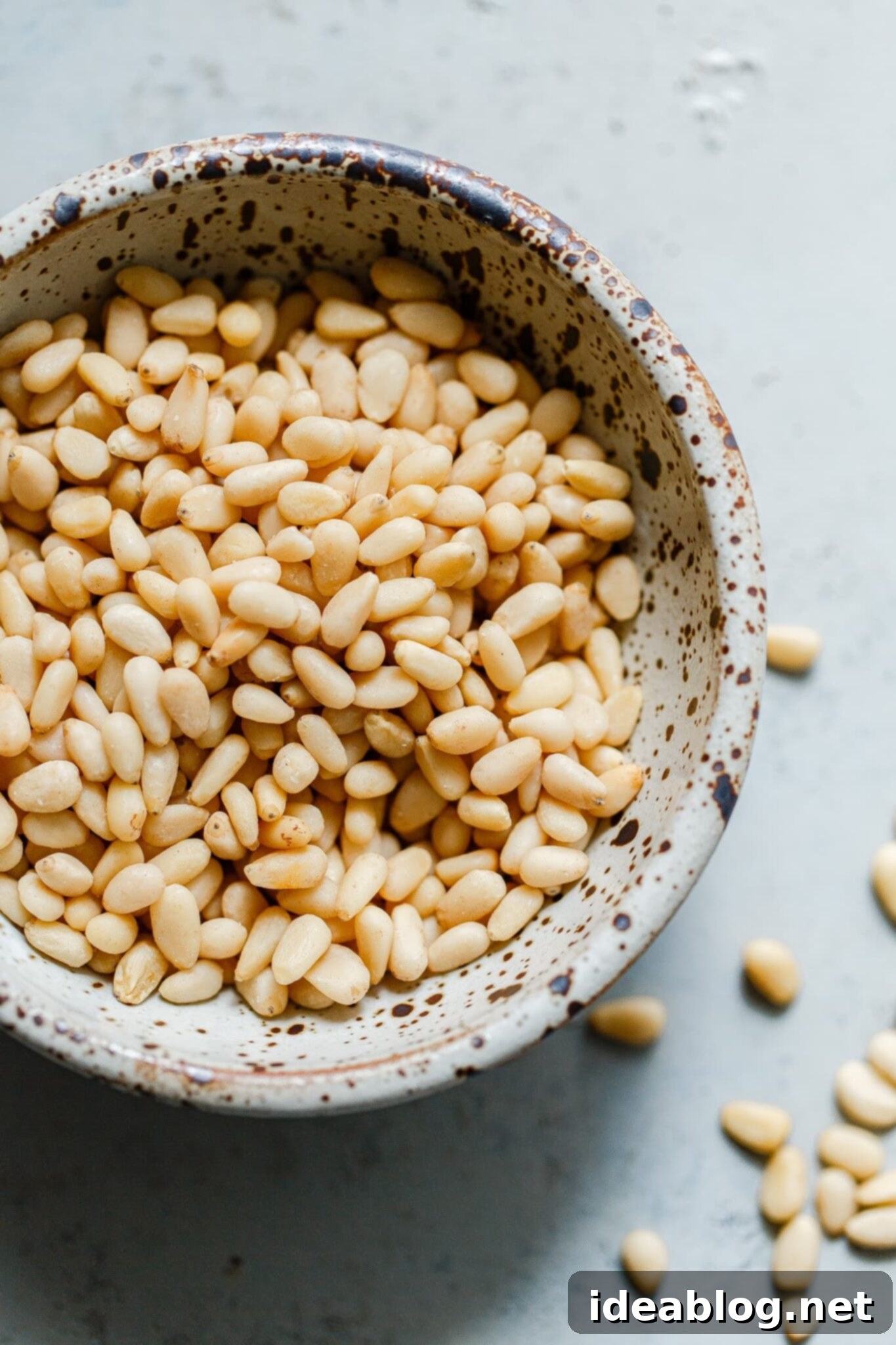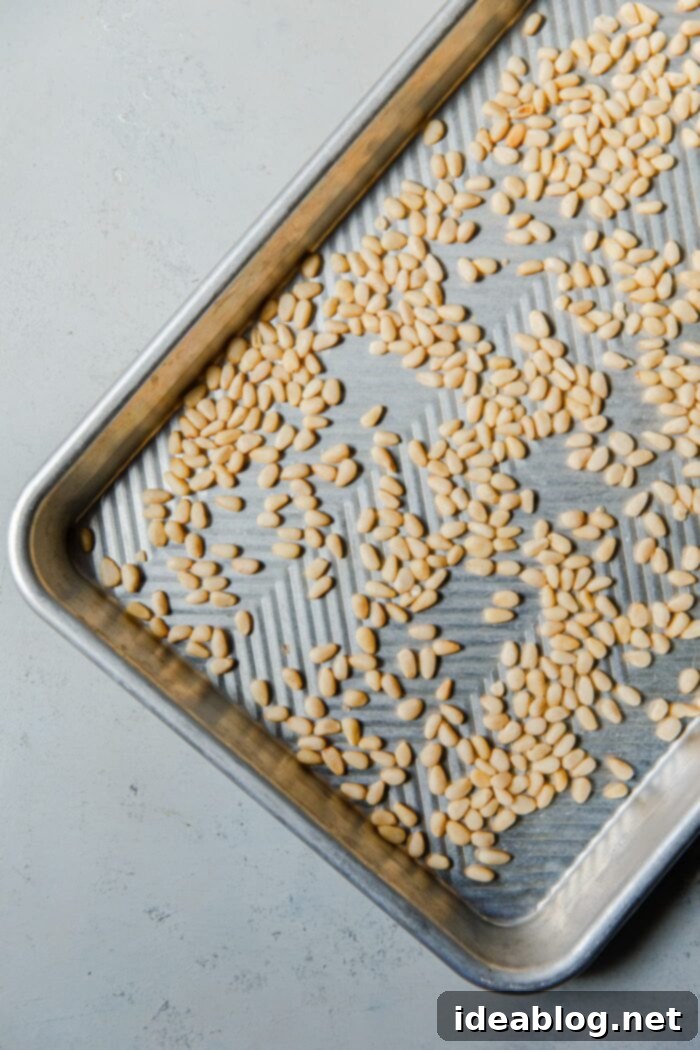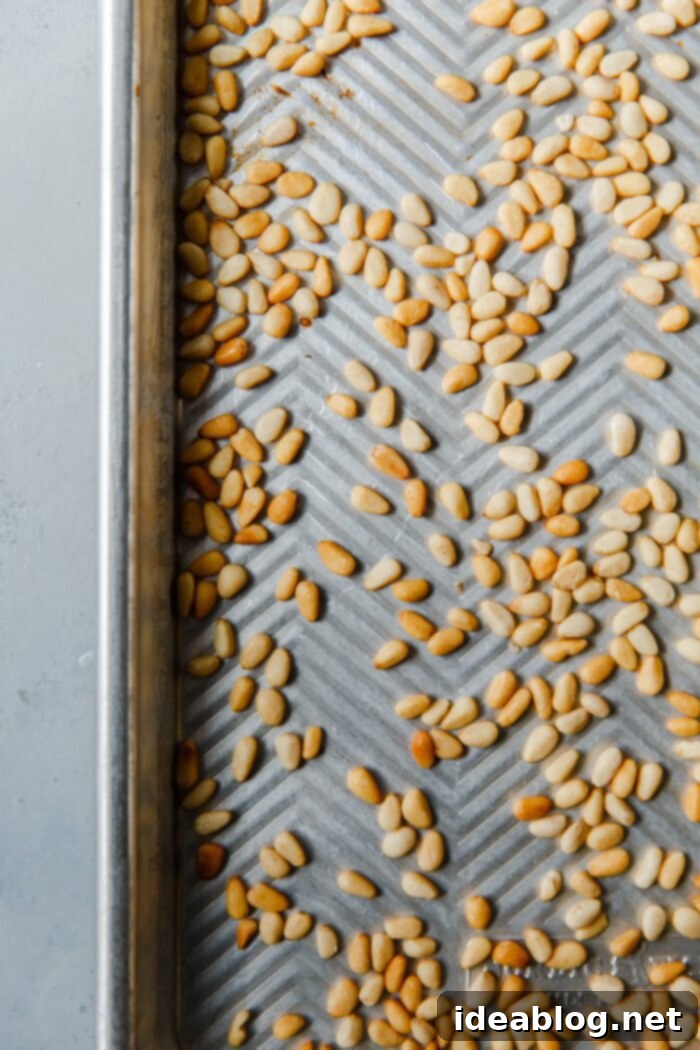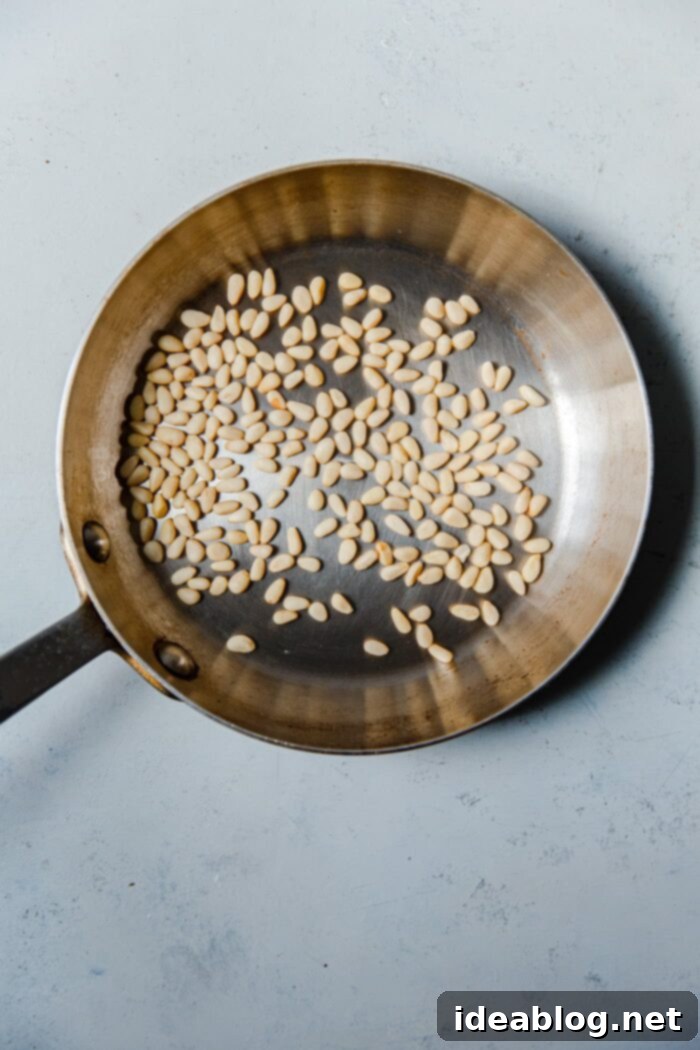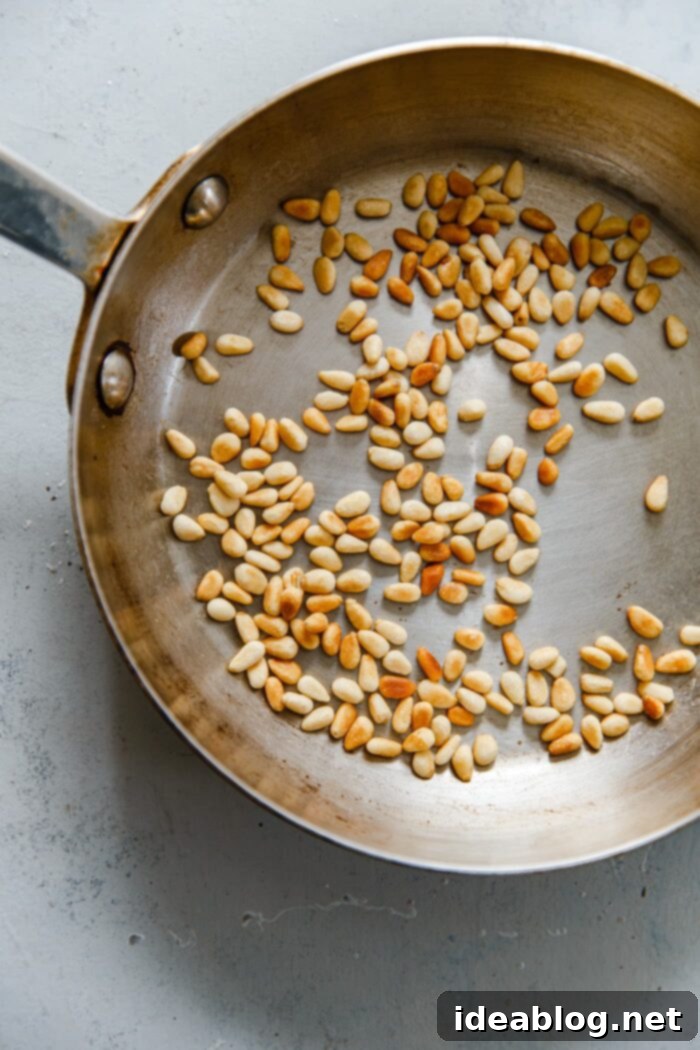The Ultimate Guide to Toasting Pine Nuts: Unlock Their Full Flavor Potential (Oven, Skillet, Toaster Oven)
This simple, comprehensive guide reveals how to toast pine nuts perfectly in your oven, toaster oven, or a dry skillet on the stove, transforming their flavor for all your culinary creations.
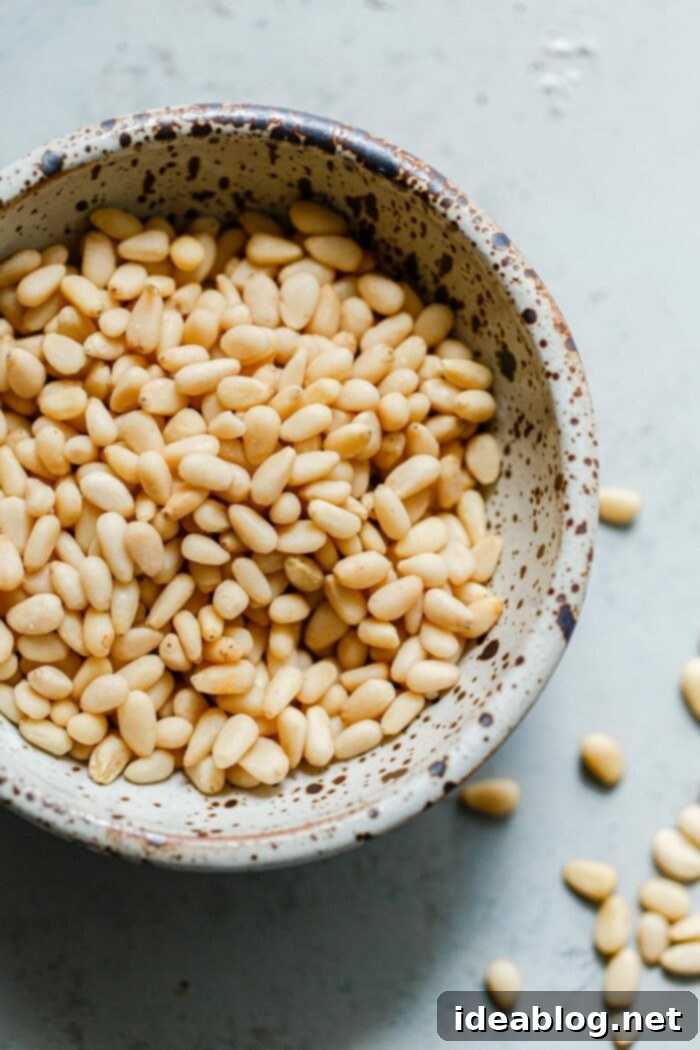
Pine nuts, known exquisitely as pignoli in Italian cuisine, are truly one of my most cherished ingredients for both cooking and baking. These small, creamy, and buttery nuts possess a delicate flavor profile that undergoes a remarkable transformation when kissed by heat.
Toasted until they achieve a beautiful golden hue and release an irresistible fragrance, pine nuts become incredibly versatile. I frequently add them to various pasta dishes, from traditional pestos to vibrant arugula pesto, where they contribute a rich texture and nutty depth. They are also fantastic tossed onto fresh, leafy salads, warm cooked grains, and even roasted vegetables, providing an extra layer of flavor and a delightful crunch.
Beyond savory applications, pine nuts are a fantastic addition to baked goods. Imagine them lending their unique character to elegant tarts, delicate cookies, and moist cakes, adding both texture and an unexpected hint of nutty sweetness. Their presence elevates any dish, making them a must-have in any well-stocked pantry.
To truly unlock and maximize their inherent flavor, I wholeheartedly recommend toasting pine nuts just before you plan to use them. This crucial step is more than just cooking; it’s a process that gently releases their natural oils, which are ultimately responsible for the majority of their captivating taste and aroma. Raw pine nuts are good, but toasted pine nuts are extraordinary. Here’s your ultimate guide to achieving perfectly toasted pine nuts every single time!
Shopping Tip: For optimal freshness and flavor control, I always recommend purchasing raw pine nuts. This advice generally extends to most other nuts as well. Raw nuts allow you to toast them exactly when needed, ensuring the best taste and aroma. Once purchased, store them in the refrigerator or freezer to significantly extend their shelf life and prevent rancidity, which can occur quickly due to their high oil content.
Why Toast Pine Nuts? The Flavor Transformation Explained
Toasting pine nuts is not merely an optional step; it’s a culinary revelation that profoundly enhances their flavor and aroma. When raw, pine nuts are soft, pale, and possess a milder, almost subtly resinous taste. While edible, their full potential remains dormant. The application of gentle heat, however, initiates a series of chemical reactions, most notably the Maillard reaction, which is responsible for the enticing browning and complex flavors in many cooked foods.
This process coaxes out the natural oils within the nuts, intensifying their inherent sweetness and developing a much deeper, richer, and more buttery nutty flavor. The heat also crisps up their texture, providing a delightful textural contrast that can elevate a simple salad or a sophisticated dessert. By toasting, you transform a mild ingredient into a vibrant, aromatic powerhouse that adds a layer of sophistication to countless dishes. Skipping this simple step means missing out on a significant and easy enhancement to your recipes.
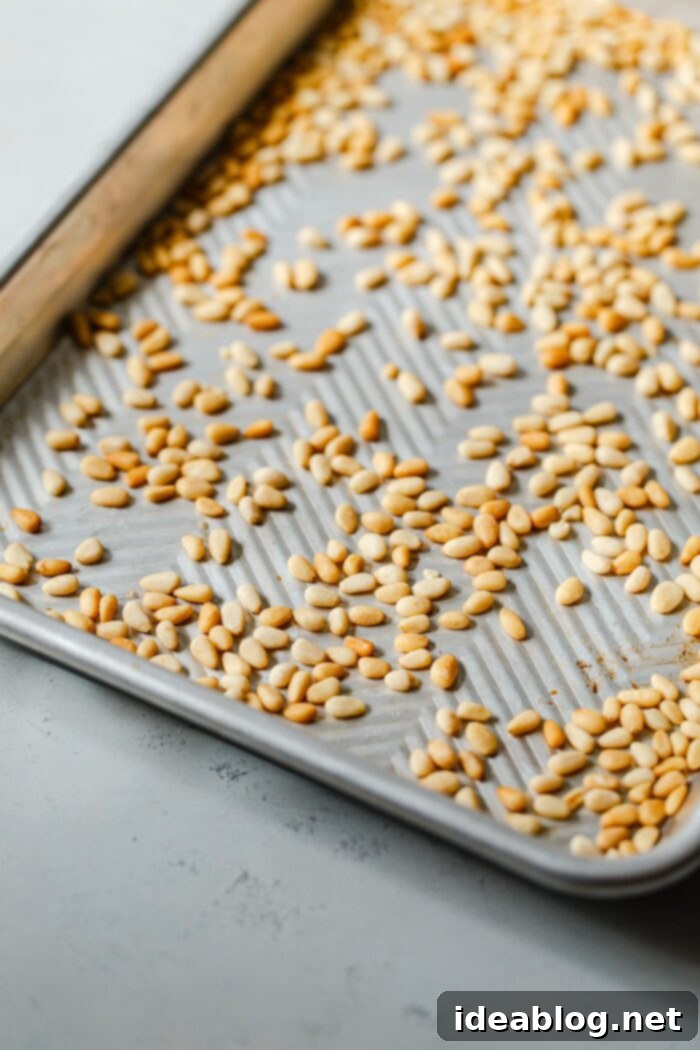
How to Toast Pine Nuts in an Oven (Or Toaster Oven)
My preferred method for toasting pine nuts is using an oven (or a toaster oven). While it might require a few more minutes compared to the stovetop method, the oven provides a more consistent and even heat distribution. This means less constant stirring on your part and results in much more uniformly toasted nuts. This method is particularly recommended when you need to toast larger quantities of pine nuts, typically more than ¼ or ½ cup, as it minimizes the risk of uneven browning or burning.
Equipment You’ll Need:
- A half sheet pan (standard size baking sheet) or a quarter sheet pan (for smaller batches). Lining it with parchment paper is optional but makes cleanup effortless.
Step-by-Step Oven Toasting Instructions:
- Preheat the Oven: Begin by preheating your standard oven or toaster oven to 350°F (175°C). Ensuring the oven is at the correct temperature before you start is crucial for even toasting. Spread the raw pine nuts evenly in a single layer across the sheet pan. Avoid overcrowding, as this can cause the nuts to steam rather than toast, leading to a less crispy result. If you have a large quantity, consider using two pans or toasting in batches.
- Bake and Monitor: Place the sheet pan in the preheated oven and bake for approximately 5 to 8 minutes. The exact timing can vary slightly depending on your oven’s calibration and the size of the pine nuts. Mid-way through the baking time (around the 3-4 minute mark), gently toss or stir the pine nuts on the pan. This ensures they brown evenly on all sides. Keep a very close eye on them during the final minutes; pine nuts can transition from perfectly golden and fragrant to burnt very quickly. You’re looking for a rich, golden color and a noticeable, enticing nutty aroma.
- Cool Immediately: As soon as the pine nuts achieve that perfect golden color and fragrant aroma, immediately transfer them from the hot sheet pan to a separate heatproof bowl or plate. Leaving them on the hot pan will allow the residual heat to continue cooking them, potentially resulting in over-toasting. Let them cool completely before you incorporate them into your recipes or store them. As they cool, they will become even more crisp and their enhanced flavor will set.
Tips for Success with the Oven Method: This method is ideal if you are toasting larger quantities (more than ¼ or ½ cup) of nuts, as it provides consistent results with less active supervision. Always use a timer, and trust your sense of smell – the fragrant aroma is your best indicator of doneness.
How to Toast Pine Nuts in a Skillet (Stovetop)
The dry skillet method is undoubtedly the fastest way to toast small amounts of pine nuts (and other nuts). This makes it perfect when you need a quick garnish or just a handful for a recipe. However, pine nuts are inherently small, delicate, and notorious for burning very quickly, especially on the stovetop. Therefore, this method requires your full, constant, and undivided attention from start to finish.
Equipment You’ll Need:
- A medium-sized, dry skillet (a non-stick pan or a well-seasoned cast-iron skillet works best for even heat).
Step-by-Step Skillet Toasting Instructions:
- Prepare the Skillet: Place the raw pine nuts in a dry skillet. Do not add any oil or butter, as this can cause them to fry rather than toast, and it can also mask their delicate flavor. Set the skillet over medium heat.
- Stir Constantly: This is the most critical step for stovetop toasting. Stir the pine nuts almost continuously with a wooden spoon or spatula. The goal is to move them around constantly to ensure they brown evenly without scorching. Be prepared to adjust the heat as needed; if they start browning too quickly, immediately reduce the heat to medium-low. Continue this stirring and monitoring process until the pine nuts become very fragrant and turn a beautiful, uniform golden color, typically within about 4 to 5 minutes. Their small size means they heat up and brown very rapidly, so do not walk away from the stove.
- Cool Immediately: As soon as they reach the perfect toasted stage, immediately transfer the toasted pine nuts from the hot skillet to a heatproof bowl or plate. The residual heat in the pan will continue to cook them, and they can go from perfect to burnt in a matter of seconds. Let them cool completely before using them in your dishes or storing them. This allows them to crisp up further and solidifies their enhanced nutty flavor.
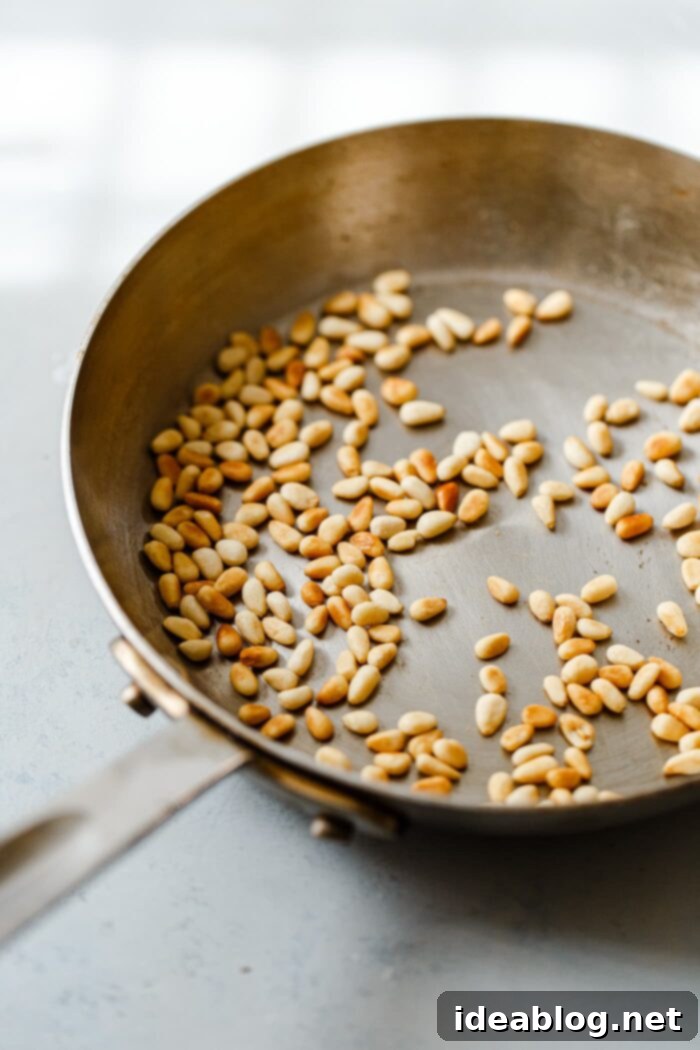
Common Mistakes to Avoid When Toasting Pine Nuts
While toasting pine nuts is a simple process, a few common errors can quickly lead to less-than-perfect results. Being aware of these pitfalls will help you achieve beautifully toasted nuts every time:
- Over-toasting and Burning: This is arguably the most frequent mistake. Pine nuts burn very easily due to their high oil content and small size. Always err on the side of under-toasting; it’s better to remove them from the heat source a little earlier if you’re unsure. Remember, they will continue to darken slightly as they cool from residual heat.
- Uneven Toasting: This typically occurs when the nuts are overcrowded on the baking sheet or in the skillet, or when they aren’t stirred/tossed frequently enough. For oven toasting, ensure a single, even layer. For stovetop, constant stirring is non-negotiable.
- Adding Oil (Unless Specified): Unless a specific recipe explicitly calls for it, toast pine nuts in a dry pan. Adding oil can cause them to fry and become greasy, altering their delicate texture and masking their natural flavor. The goal is to release their own oils.
- Not Cooling Immediately: Leaving toasted pine nuts on a hot baking sheet or in a hot skillet after they’re done is a common error. The residual heat will continue to cook them, often resulting in burnt nuts. Always transfer them to a cool bowl or plate immediately.
- Improper Storage: Storing toasted nuts improperly can lead to them becoming stale, losing their crispness, or even developing an off-flavor. Always use an airtight container, and consider refrigeration or freezing for maximum freshness.
The Nutritional Benefits of Pine Nuts
Beyond their delightful taste and culinary versatility, pine nuts offer a surprising array of nutritional benefits, making them a healthy addition to your diet. They are a good source of healthy fats, particularly monounsaturated and polyunsaturated fats, which are known to support heart health and help lower bad cholesterol levels. These tiny nuts also provide a decent amount of plant-based protein, making them a great choice for vegetarians and vegans looking to boost their protein intake.
Furthermore, pine nuts are rich in dietary fiber, which aids in digestion and promotes a feeling of fullness, contributing to weight management. They are packed with essential minerals like magnesium, iron, and zinc, all vital for various bodily functions, from energy production to immune support. Additionally, pine nuts contain important vitamins such as Vitamin E, a powerful antioxidant, and Vitamin K, which is crucial for blood clotting and bone health. Incorporating toasted pine nuts into your meals not only elevates their flavor and texture but also provides a convenient and delicious way to boost your nutrient intake.
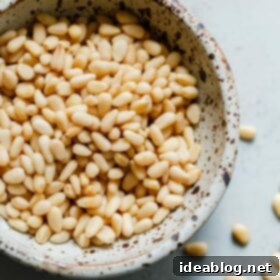
Toasted Pine Nuts
Pin
Review
SaveSaved!
While the dry skillet method is undoubtedly faster for small quantities, the oven method is my preferred choice due to its ability to produce more evenly toasted nuts with less constant vigilance. Refer to the detailed notes section below for additional tips and expert advice to ensure your pine nuts are perfectly toasted every time.
Equipment
-
Half Sheet Pan
-
Medium Skillet
Ingredients
- ¼ cup raw pine nuts sometimes referred to as pignolias
Instructions
Oven / Toaster Oven Method:
-
Preheat the oven (or toaster oven) to 350°F (175°C). Spread the raw pine nuts evenly on a half sheet pan (or quarter sheet pan) in a single layer.
-
Bake for 5 to 8 minutes, making sure to toss them halfway through the cooking time to ensure even browning. Continue baking until the pine nuts are deeply fragrant and visibly golden in color. Immediately transfer the toasted pine nuts from the hot pan to a heatproof bowl or plate to stop the cooking process. Allow them to cool completely before using.
Dry Skillet (Stovetop) Method:
-
Place the raw pine nuts in a dry skillet (no oil or butter) and set over medium heat. Stir them frequently, almost constantly, adjusting the heat as needed if they brown too quickly. Continue stirring until the pine nuts are intensely fragrant and have turned a consistent golden color, typically within about 4 to 5 minutes.
-
Immediately transfer the toasted pine nuts from the hot skillet to a heatproof bowl or plate to prevent them from burning. Let them cool completely before using them in your recipe.
Tips for Success:
- If you’re toasting larger quantities of nuts (more than ¼ or ½ cup), the oven method is highly recommended over the dry skillet method for more even results and less risk of burning.
- Always purchase raw pine nuts (and most other nuts) for all your cooking and baking applications to ensure the freshest flavor. Store them in an airtight container in the refrigerator for up to three months, or in the freezer for up to six months to maximize their shelf life and prevent them from going rancid.
- Never Walk Away: Whether using the oven or skillet, pine nuts can go from perfectly toasted to burnt in moments. Stay vigilant, especially during the last few minutes.
- Cool Completely: Always allow toasted pine nuts to cool entirely before adding them to dishes or storing them. This allows them to crisp up properly and prevents condensation in storage.
Conclusion: Elevate Your Dishes with Perfectly Toasted Pine Nuts
As we’ve explored, toasting pine nuts is far more than a minor step in a recipe; it’s a simple yet incredibly impactful technique that unlocks a world of intensified flavor and captivating aroma. By transforming these humble raw nuts into golden, fragrant, and delightfully crisp kernels, you elevate their inherent buttery sweetness and nuttiness, making them an indispensable ingredient in both sweet and savory dishes.
Whether you opt for the hands-off reliability of the oven method, which excels at even browning for larger batches, or the quick precision of the stovetop skillet for smaller, immediate needs, a few minutes of care and attention are all it takes. With the straightforward methods, invaluable tips, and common pitfalls to avoid detailed in this guide, you are now fully equipped to toast pine nuts perfectly every single time.
So go ahead, embrace this simple culinary technique. Grab some raw pignoli, toast them to that irresistible golden perfection, and prepare to enjoy the rich, buttery goodness and enhanced texture they bring to your next pasta dish, salad, baked good, or any other creation. Your taste buds, and your recipes, will thank you!
